Final report for FNC17-1108
Project Information
I am the 4th generation to farm the land on our 440 acre Century Farm. We primarily raise corn, soybeans and sweet corn since selling our dairy herd in 2012. When we had the dairy cows, alfalfa, barley and corn silage were an integral part of our rotation to feed our dairy cows. Before this grant we really didn't have any sustainable practices besides having more than corn and soybeans in our rotation like we do now. Ever since selling the cows and going to a corn/soybean rotation, I've noticed a change in our soils, particularly in structure and tilth. This was causing me some concern and gave me the motivation to try some new conservation practices as we transition our farm to the 5th generation.
Problem
The problem is that I’m getting concerned about the sustainability of our current management system (corn/soybean rotation, conventional tillage) and would like to implement cover crops and strip tillage on my farm. The second part of the problem is seeding cover crops and strip tillage require two passes across the field, that’s why I’d like to integrate the two systems into one pass. With the low prices, lack of time and labor, I’m trying to reduce trips across my fields and make sure my farm is sustainable for the next generation. I feel these problems are faced by farmers all over the North Central Region and I would like to try and solve these problems!
Wind erosion (black snow) in the winter from our conventionally tilled fields and I don’t like to see my expensive land (and all of the neighbors fields too) just blow away! There are very few farmers in our area who have tried cover crops. I read lots of articles of how farmers south of us are implementing cover crops but we are so far north that everyone seems afraid to try anything. Figuring out which mix of species can provide winter cover to our land, spring growth and residue for the early growing season (May/June). It just seems like our weather is so wild that we get these huge rain events in April-June and even though most of our land is fairly level (A slopes), we still get soil erosion. There is some university data on strip till, but I really don’t like to make any major decisions until I see how something performs on my farm.
I believe that solving this problem is very important will benefit the farmers and ranchers in the North Central
Region in many ways.
Solution
The focus of this grant is to improve soil health, reduce soil erosion and make farming more sustainable while strip tilling and seeding a cover crop. These are not innovative practices by themselves but when combined become an innovative practice.
Objectives & details
- Trial Time Period:
- August 2017-November 2018
- Trial Design
- The trial will be placed on two 70 ac fields split in half to be compared with conventional farming practices. 35 ac
of each field will be conventionally tilled and the other 35 acres will be strip tilled with cover crops seeded. Tillage
will take place following soybean harvest (approx. end of September) during the recommended seeding window
to allow for fall germination and growth of the species. A second strip tillage pass will be planned the following
spring to prepare the seedbed for corn. - Two different mixes of cover crops will be used that will be able to survive the winter. Mix 1 will have more
grasses such as cereal rye, triticale, etc. Mix 2 will have more broadleaves such as hairy vetch, clovers, etc. - If possible, I’d like to see if I could let Mix 2 keep growing with the corn crop, without compromising weed control.
- The trial will be placed on two 70 ac fields split in half to be compared with conventional farming practices. 35 ac
- Machinery design
- Utilizing a strip till machine, mount a gandy air seeder box with tubing to go between the strip till units to
broadcast the seed on the soil.
- Utilizing a strip till machine, mount a gandy air seeder box with tubing to go between the strip till units to
- Increase soil health
- Cover crops will add needed organic matter to the soil
- Feed the microbes
- Help to build soil structure
- Reduce compaction
- Reduce soil erosion
- Through the use of cover crops growing during the winter, spring and early summer
- Improve water quality
- Using cover crops
- Yield
- Measure the effects on corn yield
One of the biggest objectives was Machine design. In the summer of 2017 I mounted a valmar air seeder onto my ETS soil warrior to allow for air delivery of the cover crops between the row units. This task required welding and fabrication of brackets to mount the valmar seeder, calculating and calibrating the ground drive system for the proper seeding rate and mounting hoses to deliver the cover crop seed precisely between the rows of my soil warrior.
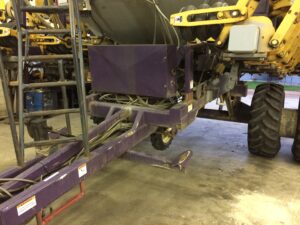
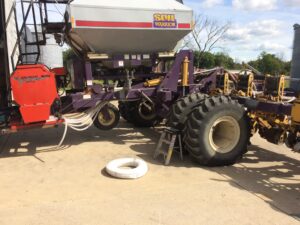

The next objective was picking cover crop species to fit my resource concerns. I had originally planned on getting the cover crops seeded during the last week of september and using a diverse species mix. Due to a later and colder than normal soybean harvest, I had to deviate from my originally planned mixes. I decided to pick three different species that would handle the colder temperatures of the fall and two of the species having the chance to overwinter to provide benefit during the spring of 2018. I selected rapeseed, hairy vetch and cereal rye for my three species. Each species was seeded individually with the seeding rates as follows: Rapeseed, 5#/ac. Hairy Vetch, 5 & 10#/ac and Cereal rye, 40 & 80#/ac.
Cooperators
Research
Basically I wanted to incorporate cover crops into my farming operation by integrating the seeding of them with another field operation pass because there just isn't enough time in the fall to add another pass to seed cover crops. So I decided the best way for me to do this would be to seed the cover crops as I'm doing my fall strip till pass.
A few benefits to doing it this way are:
- Time and labor savings
- no other field operations pass is required
- perennial species used
- species are used that will overwinter and provide benefit the following spring and also benefit the following crop
- banding of the cover crop seed between the strips
- I think this will be the biggest benefit especially when trying cereal rye or another cover crop with a high C:N ratio before corn. As the cereal rye grows the next spring, there won't be any seed on my strips and they'll still be black, allowing for easy corn planting and reduced risk for the cereal rye tying up nitrogen after its terminated. Plus I might be able to keep the cereal rye growing for a longer period until the corn emerges versus terminating it before planting.
The first results of the project-some of the cover crops survived and came up right away in the spring!

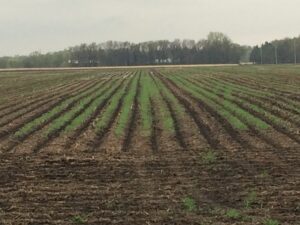
The final result was how the cover crop would affect the yield of our cash crop. Granted this is only one year of data, I'm happy with the results. Analysis of the yield data from a calibrated combine monitor showed no difference in corn yield following a cover crop! The yield map below shows the two cover crop check strips indicated by the black border. The left strip was the cereal rye blend and the right strip was rapeseed.
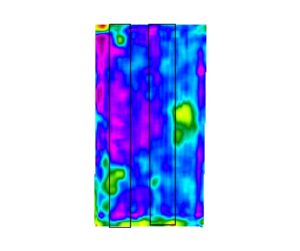
Educational & Outreach Activities
Participation Summary:
The main method for telling others about my project was just visiting with my fellow farming friends who share an interest in cover crops and soil health as well as industry personnel from the NRCS/SWCD and even my Soil Warrior dealer.
Probably the quickest method was posting a picture on twitter this past fall while strip tilling.
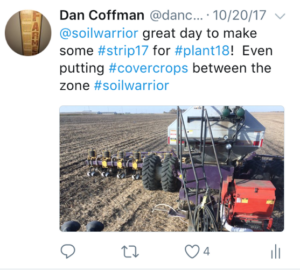
The second outreach activity was showcasing the project at a local field day, collaborating with our local NRCS/SWCD and the Minnesota Corn Growers. The field day was well attended, with about 20 farmers present and about 6 industry personnel. This was the first "soil health/cover crop" field day held in Nicollet county that I'm aware of! There were a variety of projects showcased at this event, mainly custom built cover crop seeding machines to interseed cover crops into corn at V4 and again at tassel. Also there was another project that developed a method to "strip till" liquid swine manure. It was a great event, with a presentation from a NRCS soil scientist talking about soil structure and showing everyone the slake test. Also, each farmer got to showcase and talk about their individual piece of equipment that they developed to seed cover crops with great interaction and interest from the audience.
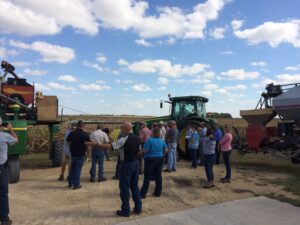
Learning Outcomes
The biggest thing I've learned so far is that using cover crops requires some thinking and sometimes you have to really think! I don't know of anybody else or any equipment manufacturer who is seeding cover crops while strip tilling so my resources for questions was slim at best. Putting together a system from scratch requires a lot of planning, testing and re-engineering to make it work. I even had to switch cover crop species as the fall got later than expected so that I could still reap the benefits of using them.
Project Outcomes
"If you can get this system to work on your farm, I'd love to try it on my farm next fall"
-Local Nicollet County, MN farmer
I'd maybe recommend looking into trying to seed the cover crops earlier in the fall to get some fall growth, such as around early september in the standing crops with some type of high clearance applicator (not an airplane). Planting an early maturity soybean variety would really help with this.
I think more research needs to be done in the area of cover crop affects on crop yield, especially using a grass cover crop (cereal rye) before corn. Being so far north, we really don't have any legumes that can be seeded in the fall and will reliably overwinter to benefit the following corn crop. The hairy vetch that I seeded didnt overwinter. This could be due to later planting.
I am going to continue this project on my own and try to get a few years worth of data on my farm to see how the cover crops affect yield and to explore different seeding methods.